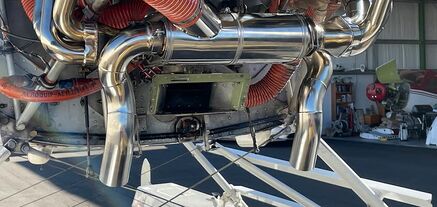Muffler (Aircraft Engine)
Jump to navigation
Jump to search

Introduction[edit | edit source]
In the context of aircraft engines, a muffler, also known as a silencer, is a crucial component of the exhaust system, responsible for reducing engine noise and, in some cases, directing exhaust gases away from the engine, fuselage, and cabin.
Function[edit | edit source]
- Noise Reduction: The primary function of an aircraft muffler is to dampen the loud sounds produced by the engine's exhaust.
- Exhaust Gas Management: Mufflers help direct exhaust gases away from the engine, fuselage, and cabin, preventing potential hazards like carbon monoxide poisoning or fire.
- Heat Exchange: In some aircraft, mufflers can also be used to extract heat from the exhaust gases for cabin heating or carburetor heat.
Importance[edit | edit source]
- Safety: A malfunctioning muffler can lead to serious consequences, including cabin contamination with exhaust gases, engine power loss, and even fire.
- Engine Performance: Proper exhaust system function, including the muffler, is essential for optimal engine performance and efficiency.
Types of Aircraft Exhaust Systems[edit | edit source]
- Piston Engine Aircraft: These systems typically involve an exhaust manifold, pipes, and mufflers to route exhaust gases overboard.
- Turbine Engine Aircraft: Turbine engines have more complex exhaust systems that often include mufflers or silencers to reduce noise and manage exhaust flow.
Maintenance[edit | edit source]
- Regular inspection and maintenance of aircraft mufflers are crucial to ensure their proper function and prevent potential problems.
- FAA (Federal Aviation Administration) recommends that exhaust stacks, mufflers, and tailpipes be replaced rather than repaired, since special tools and welding skills are needed.
Common Issues[edit | edit source]
- Cracks and Leaks: Mufflers can develop cracks or leaks, allowing exhaust gases to escape into the cabin or surrounding areas.
- Loose Baffles and Cones: Loose internal components can cause engine power loss and potentially lead to engine failure.
- Corrosion: Exposure to high temperatures and corrosive environments can lead to corrosion of muffler components.